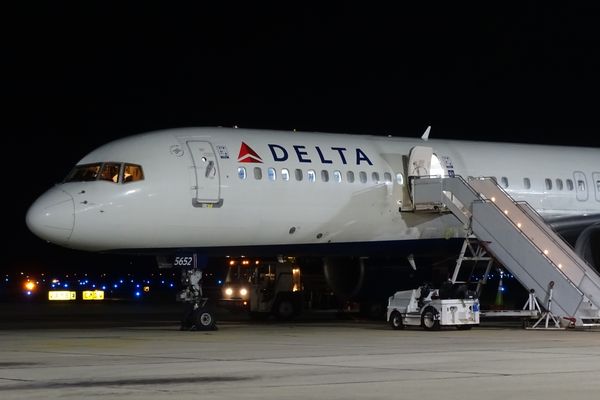Over the next two months, Air New Zealand (ANZ) will be administering a voluntary survey to its passengers, in which passengers will be weighed before boarding their ANZ flights. According to the airline, the survey "...is essential to the safe and efficient operation of the aircraft and is a [New Zealand] Civil Aviation Authority requirement..."

When a passenger who chooses to participate in the novel survey is weighed at the airport, the data about the passengers' weight will be completely anonymous, and not disclosed through any means (digital or otherwise) to any airport employees, ANZ cabin crew, or pilots.
"We want to reassure our customers there is no visible display anywhere. No one can see your weight - not even us!" states Air New Zealand Load Control Improvement Specialist Alastair James, reassuring wary passengers in the airlines' press release regarding the new survey.
The Novel Survey Will be Carried Out at Auckland International Airport (AKL)
The survey will only be administered to Air New Zealand passengers who wish to take it at lounge entrances, along with gates for international flights (AKL-SYD, LAX, SFO, SIN, for example) at AKL airport between May 29 and July 2, 2023.
It may sound strange for an airline to begin to weigh passengers. In our current time, it is, but this may become more commonplace in the future. There is a reason why there are luggage weight limits and requirements that passengers have to follow when flying. This is due to the major effect that weight has on an aircraft's performance in general. This becomes more critical on takeoff and landing.

Knowing the average weight of passengers onboard an aircraft with data from the currently ongoing survey, along with the weight of other items such as baggage and meals will allow Air New Zealand to more efficiently load and distribute weight on its aircraft.
This in turn will allow for increased efficiency and a longer range. This can be particularly beneficial on the airline's already highly efficient and long-range Boeing 777-300ERs and Boeing 787-9s. This could make routes previously thought impossible, possible, such as Auckland to London or Paris.
Customers flying Air New Zealand's domestic network were weighed in the same fashion in 2021. According to the airline, because of international air traffic's rebound post-pandemic, "...it's time for international flyers to weigh in..."
Background: About Air New Zealand
ANZ has been representing the Kiwi nation for 83 years, operating its first flight between Auckland and Sydney on April 30, 1940. Since its establishment in the early '40s, the airline has grown from a fleet of 1 flying boat, a Shorts S.30 (ZK-AMA, named Aotearoa) to 106 aircraft in 2023.
Most Air New Zealand planes are regional turboprops, with just under half of the airline's fleet (52 aircraft comprising of ATR 72-600s, and DASH 8 Q300s) flying the carrier's large domestic feeder network. The rest of ANZ's fleet (52 aircraft for a total of 106) are as follows: 17 Airbus A320s, 14 Boeing 787-9s, 10 Airbus A321neos, 7 Boeing 777-300ERs, and 6 Airbus A320neo aircraft.

Air New Zealand and the airlines' Australian flag carrier counterpart Qantas are known for their ultra-long-haul flights. In September of 2022, the airline inaugurated the nearly 18-hour flight between its Auckland (AKL) hub and New York JFK using a modified Boeing 787-9. The carrier also operates other ultra-long-haul routes such as Auckland to Chicago (ORD), Houston (IAH), and Vancouver (YVR).
Currently, Air New Zealand has hubs in Auckland (AKL), Wellington (WLG), and Christchurch (CHC), along with one secondary hub in Queenstown (ZQN). Pre-COVID, the airline transported 17 million passengers.
Alaska Airlines Defends Home Turf with 7 Strategic New Routes for 2026 » Memphis at Midnight: Inside FedEx's Global Superhub » The Top 5 Longest Flights in the World »
Comments (0)
Add Your Comment
SHARE
TAGS
NEWS Air New Zealand New Zealand Boeing Airbus A320 B777-300ER International Auckland AKL PassengersRECENTLY PUBLISHED
 Game Day: The Unseen Operation Behind College Sports Travel
At one of the largest Division I programs in the country, six-figure sports charters quietly keep game day moving. We went airside at the University of Illinois-Willard Airport to see who plans them, how aircraft and crews are positioned, and why a single schedule change can ripple through an entire airline.
STORIES
READ MORE »
Game Day: The Unseen Operation Behind College Sports Travel
At one of the largest Division I programs in the country, six-figure sports charters quietly keep game day moving. We went airside at the University of Illinois-Willard Airport to see who plans them, how aircraft and crews are positioned, and why a single schedule change can ripple through an entire airline.
STORIES
READ MORE »
 Coloring the Clouds: How ANA Turned Airplanes into Art
ANA's long-running tradition of special liveries has transformed its fleet into a flying gallery of Japanese culture, featuring iconic partnerships with franchises like Pokémon, Star Wars, and Demon Slayer. We explore these liveries and the stories behind them.
INFORMATIONAL
READ MORE »
Coloring the Clouds: How ANA Turned Airplanes into Art
ANA's long-running tradition of special liveries has transformed its fleet into a flying gallery of Japanese culture, featuring iconic partnerships with franchises like Pokémon, Star Wars, and Demon Slayer. We explore these liveries and the stories behind them.
INFORMATIONAL
READ MORE »
 End of an Era: JetBlue's Farewell to the Embraer E190
On September 9, 2025, after nearly two decades of service, JetBlue Airways brought an end to an era with the retirement of its Embraer E190 fleet.
INFORMATIONAL
READ MORE »
End of an Era: JetBlue's Farewell to the Embraer E190
On September 9, 2025, after nearly two decades of service, JetBlue Airways brought an end to an era with the retirement of its Embraer E190 fleet.
INFORMATIONAL
READ MORE »



